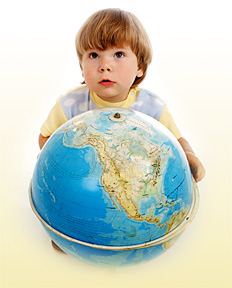Friday, May 27, 2011
Fever in your child: time to panic or to allow the body to heal?
Dr. Philip Incao in an article regarding this issue stated:
Children’s Health: A Question of Balance: (Pathways magazine, 12/01/2010)
“Antibiotics, aspirin, ibuprofen and other anti-inflammatory drugs cool down and suppress the fire of the immune system so that symptoms subside before the illness has fully worked its way out of the body.
“In healthy people, the inflammatory response of the immune system rarely gets out of control. In such cases an antibiotic may be called for. Although an antibiotic may be lifesaving, it never heals an inflammation- it only suppresses it. The causes of the inflammation must still be healed after the antibiotic treatment. Otherwise, the immune system may remain weakened."
Why does a person typically get a fever? It is a signal from the body, a messenger if you will, telling the body that there is a healing crisis going on. It is the body’s attempt to heal, overcome something foreign or toxic that the body needs to get rid of. Attempting to get rid of the fever with an ‘antipyretic’ (or fever suppressing medicine) is like killing the messenger.
Reactions to medicines and immunizations can produce fevers because the body is attempting to cope with the toxin that has just been introduced to it. The best approach is to be calm and to make your child as comfortable as possible. Keep them warm, well hydrated, and only have them eat when they have an appetite and even then easy to digest foods like broth, the famous chicken noodle soup, herbal teas and juices are good choices.
Sleep is one of the most powerful elixirs in any healing crisis. Help your child be at ease and they often understand that their body is healing itself. My one son always knew what to eat and in what quantity even when he was a young child.
-Dr. Bill Lawler
Here is the link for the full article:
http://pathwaystofamilywellness.org/component/option,com_crossjoomlaarticlemanager/Itemid,49/lang,en/view,crossjoomlaarticlemanager/
Wednesday, May 4, 2011
My kids are drug addicts and they're only 10
In December 2010, The Wall Street Journal reported the latest findings by Medco Health Solutions Inc., which determined that roughly one in four children and 30 percent of adolescents between the ages of 10 and 19 are taking a medication for a chronic condition in the United States. Nearly 7 percent of children are taking two or more such drugs, according to the company's research for 2009.
Some believe this trend is just the result of doctors and parents becoming more aware of drugs as an option for kids, but the problem remains that many of these drugs have not been tested specifically for the pediatric population. Danny Benjamin, a Duke University pediatrics professor, is specifically concerned about the well-established drugs since the pharmaceutical companies have no incentive to test them. "We know we're making errors in dosing and safety," said Benjamin
A Worldwide Problem
As with most trends in the United States, other countries like Canada, the United Kingdom and Australia tend to follow suit. For instance, despite the guidelines set forth by the National Institute for Health and Clinical Excellence, the number of prescriptions written in the U.K. for Ritalin is up 33 percent and in Canada, the use of ADHD drugs increased almost 50 percent between 1999 and 2004, according to IMS Health Canada. Although no current figures are available, there are very real concerns regarding the continued increase in the number of prescription drugs being given to Canadian children.
The SolutionYour chiropractor's primary goal when caring for you and your children is to allow the body to heal itself naturally. That means using conservative treatment options first, rather than turning to medication. In many cases, particularly regarding some of the pediatric conditions treated heavily with drugs these days (diabetes, high cholesterol, sleep problems, asthma, etc.) lifestyle modifications including exercise, nutrition, weight loss and stress reduction can go a long way - without drugs - to improve your child's health. Talk to your chiropractor for more information.
--------------------------------------------
There are some very alarming facts and trends highlighted in this article. Every parent needs to know there is another option! Clearly the most dangerous and expensive route is prescription drugs. It is evident that the parents only want what is best for their children and in hopes to help their children's health they reach out to the only source they know: medicare. However there is a better way. Our hope is to raise awareness for all you loving parents out there searching for the safest way to raise healthy kids! And that is what we are all about here at Chiropractic4Kids&Families!
To finish up this article here are some scary facts:
Drugging Our Children?
Many of the prescriptions or refills dispensed to children and teens in 2009 were for conditions not normally associated with children. Take a look at these staggering statistics (from most to least dispensed):
- children 0-9 years: 28.252 million
- children 10-19 years: 17.136 million
ADHD drugs: 24.357 million
- children 0-9 years: 7.018 million
- children 10-19 years: 17.339 million
Antidepressants: 9.614 million
- children 0-9 years: 1.026 million
- children 10-19 years: 8.588 million
Antipsychotics: 6.546 million
- children 0-9 years: 1.396 million
- children 10-19 years: 5.150 million
Antihypertensives (treatment for high blood pressure): 5.224 million
- children 0-9 years: 1.819 million
- children 10-19 years: 3.405 million
Sleep aids: 307,000
- children 0-9 years: 14,000
- children 10-19 years: 293,000
Non-insulin-dependent (type 2) diabetes: 424,000
- children 0-9 years: 30,000
- children 10-19 years: 394,000
Statins (treatment for high cholesterol): 94,000
- children 0-9 years: 11,000
- children 10-19 years: 83,000


